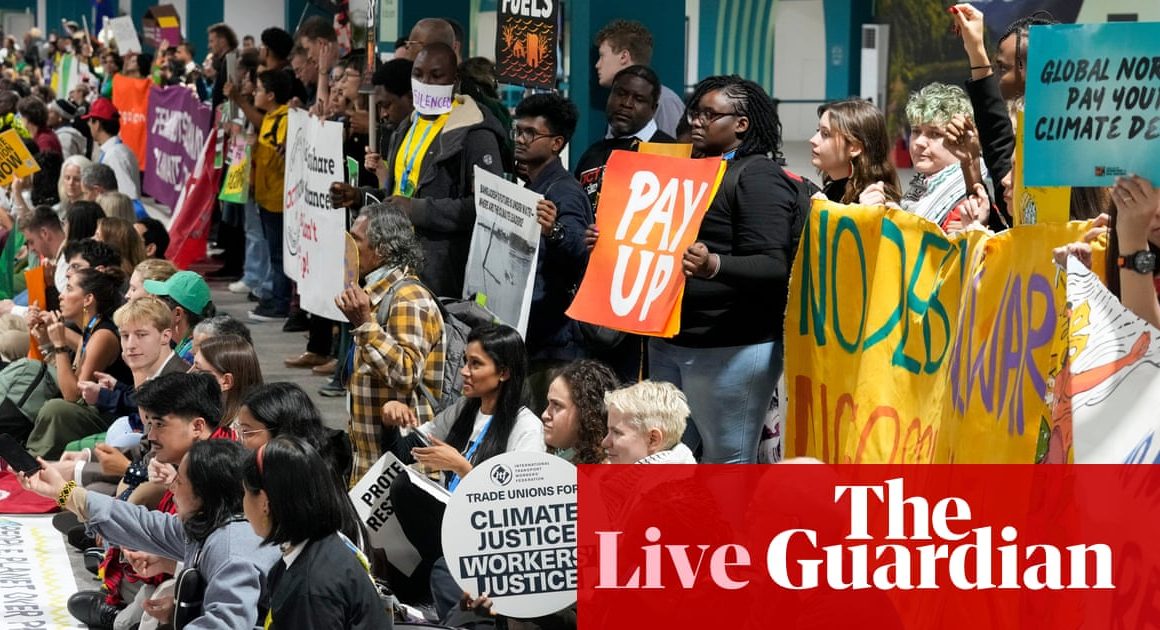Introduction: UK jobless rate drops
Good morning, and welcome to our rolling coverage of business, the financial markets and the world economy.
Unemployment across the UK has dropped unexpectedly, as more people find work – or drop out of the labour market altogether.
The latest labour market data, just released, show that the UK unemployment rate has fallen to 4.2% in April-June – the last quarter before the general election in July.
Economist had expected a rise, from 4.4% to 4.5%.
But according to the Office for National Statistics, 51,000 fewer people were unemployed in the quarter, taking the total down to 1.435 million.
Employment picked up, by around 97,000 people, to 33.094 million.
But more people dropped out of the labour market altogether — often due to sickness, or caring responsibilities – lifting the economic inactivity rate to 22.2%.
We’ve published the latest UK labour market figures.
Headline indicators for the UK labour market for April to June 2024 show:Employment was 74.5%
Unemployment was 4.2%
Economic inactivity was 22.2%Read Labour market overview ➡️ https://t.co/vQQj7Ifzgi pic.twitter.com/bcwZzdJXpO
— Office for National Statistics (ONS) (@ONS) August 13, 2024
The ONS also estimates that vacancies in the UK decreased in May to July 2024 by 26,000 on the quarter, to 884,000.
ONS director of economic statistics Liz McKeown says:
“There was a fall in the unemployment rate, which is now lower than a year ago. Meanwhile, there was a modest increase in both the total numbers of people in employment and the number of employees on payroll in the latest quarter.
“However, the medium-term picture remains somewhat subdued with the employment rate still lower than a year ago and the growth rate in the number of payrolled employees having slowed over the year.
“The number of job vacancies continues to decline, although the total number remains above pre-pandemic levels.”
The data kicks off a busy few days for UK economic data – it’s inflation tomorrow, then the first estimate of UK GDP for April-June on Thursday, and finally retail sales on Friday morning.
The agenda
-
7am BST: UK labour market data
-
8am BST: Kantar index of UK supermarket inflation
-
10am BST: IEA monthly oil market report
-
10am BST: ZEW index of eurozone economic confidence
-
1.30pm BST: US PPI index of producer price inflation
Key events
The slowdown in pay growth in April to June is a “big win” for the Bank of England, says Thomas Pugh, economist at leading audit, tax and consulting firm RSM UK.
Pugh says the Bank’s monetary policy committee (MPC) will welcome the slowdown in wage growth in the private sector [workers may not agree, of course!].
He explains:
Regular private sector pay growth has dropped from 5.6% to 5.2% in June, that’s only a fraction above the MPC forecast of 5.1%. Wage growth should continue to trend down over the rest of this year as 2% inflation is factored into pay settlements.
“If wage growth does continue to fall over the rest of this year, it would give the MPC ample cover to cut rates again towards the end of the year, probably in November, and then be more aggressive in its rate cutting cycle in 2025, so we currently have four cuts pencilled in for next year.
“Just as importantly for households, real wages grew by 2.4%. That, combined with rising consumer confidence, should give a boost to consumer spending in the second half of this year, helping a consumer spending driven recovery.”
UK grocery inflation rises

Julia Kollewe
Newsflash: UK grocery inflation has risen for the first time since March last year, returning to the rate seen before the start of the cost of living crisis.
Supermarket prices were 1.8% higher than a year ago in the four weeks to 4 August, up slightly from 1.6% in July, according to retail analysts Kantar. This rise comes after 17 months of easing inflation from a peak of 17.5% to its lowest point since September 2021 last month.
There is a mixed picture on supermarket shelves, with prices rising across 182 product categories while the cost of 89 others dropped. Kitchen towels and baked beans are 7% and 5% cheaper respectively than this time last year.
Fraser McKevitt, head of retail and consumer insight at Kantar, said:
“Having reached its lowest rate in almost three years in July, August saw inflation nudge up again slightly. While this is noticeable following 17 straight months of falling rates, it actually marks a return to the average levels seen in the five years before the start of the cost of living crisis.
“With this kind of pricing spread, shoppers will find that the type of product they’re putting in their baskets will really dictate how much they pay.”
Pound hits one-week high after UK jobs report
Sterling is rallying in early trading, as traders react to the drop in UK unemployment.
The pound has gained almost half a cent, or 0.33%, this morning to reach $1.2809, the highest since 5 August.
Political reaction
Chancellor Rachel Reeves says there is “more to do in supporting people into employment”, after today’s jobs data showed another rise in people classed as economically inactive.
Reeves says:
“Today’s figures show there is more to do in supporting people into employment because if you can work, you should work.
“This will be part of my Budget later in the year where I will be making difficult decisions on spending, welfare and tax to fix the foundations of our economy so we can rebuild Britain and make every part of our country better-off.”
Work and Pensions Secretary, Liz Kendall MP, says the Labour government will help people get back to work:
“This is yet more evidence of the dire inheritance we face, with millions of people denied the support they need to get work and get on at work, harming their opportunities and holding back growth.
“This government will deliver the change the country is crying out for by making work pay, transforming skills, overhauling jobcentres and giving local areas the power they need to drive jobs and growth.”
An estimated 100,000 working days were lost because of labour disputes across the UK in June 2024, the ONS reports.
The majority of the strikes were in the health and social work sector, with junior doctors starting a five-day strike on 27 June.
Premier Miton: UK economy is performing well
There’s nothing in today’s UK unemployment report to spook the markets, suggest Neil Birrell, chief investment officer at Premier Miton Investors:
“It was weak US jobs data that sent markets into a tailspin, but there is no need to worry about that in the UK. The labour market is stronger than expected, with wage growth pretty much in line.
The UK economy is performing well, which will be a boost to the new government, but there probably isn’t enough in these numbers to change Bank of England policy for now.”
Across the economy, the finance and business services sector saw the largest annual regular growth rate at 6.2%.
Pay grew slowest in the construction sector, at 3.5%.
Public sector pay growth outpaces private sector
That NHS one-off bonus from June 2023 helped public sector pay to grow faster than in the private sector, in April-June.
The Office for National Statistics reports that annual average regular earnings growth for the public sector “remains strong” at 6.0% in April-June, down from 6.4% in the previous quarter.
Private sector pay growth slowed to 5.2% – the lowest since March to May 2022 (when it was 5.1%).
UK wage growth hits lowest rate in two years
UK wage growth slowed in the quarter – but earnings kept rising faster than inflation.
The ONS reports that regular pay (excluding bonuses) rose by 5.4% in April to June. That’s the lowest increase since May to July 2022 (when it was 5.2%).
Growth in total pay (including bonuses) slowed more sharply, to 4.5% (from 5.7% a month ago). However, this data is distorted by one-off bonus payments made to NHS staff in June 2023.
If you adjust for CPI inflation, regular real pay rose by 3.2% on the year, the same as the previous three-month period. It was last higher in June to August 2021, when it was 3.4%.
Total real pay rose by 2.2% on the year in April to June.
The slowdown in wage growth could encourage the Bank of England to cut interest rates twice more before Christmas, suggests Capital Economics.
They told clients:
The further easing in wage growth will be welcomed by the Bank of England as a sign that labour market conditions are continuing to cool. This lends some support to our forecast that the Bank of England will press ahead with two more 25bps interest rate cuts later this year.
Introduction: UK jobless rate drops
Good morning, and welcome to our rolling coverage of business, the financial markets and the world economy.
Unemployment across the UK has dropped unexpectedly, as more people find work – or drop out of the labour market altogether.
The latest labour market data, just released, show that the UK unemployment rate has fallen to 4.2% in April-June – the last quarter before the general election in July.
Economist had expected a rise, from 4.4% to 4.5%.
But according to the Office for National Statistics, 51,000 fewer people were unemployed in the quarter, taking the total down to 1.435 million.
Employment picked up, by around 97,000 people, to 33.094 million.
But more people dropped out of the labour market altogether — often due to sickness, or caring responsibilities – lifting the economic inactivity rate to 22.2%.
We’ve published the latest UK labour market figures.
Headline indicators for the UK labour market for April to June 2024 show:Employment was 74.5%
Unemployment was 4.2%
Economic inactivity was 22.2%Read Labour market overview ➡️ https://t.co/vQQj7Ifzgi pic.twitter.com/bcwZzdJXpO
— Office for National Statistics (ONS) (@ONS) August 13, 2024
The ONS also estimates that vacancies in the UK decreased in May to July 2024 by 26,000 on the quarter, to 884,000.
ONS director of economic statistics Liz McKeown says:
“There was a fall in the unemployment rate, which is now lower than a year ago. Meanwhile, there was a modest increase in both the total numbers of people in employment and the number of employees on payroll in the latest quarter.
“However, the medium-term picture remains somewhat subdued with the employment rate still lower than a year ago and the growth rate in the number of payrolled employees having slowed over the year.
“The number of job vacancies continues to decline, although the total number remains above pre-pandemic levels.”
The data kicks off a busy few days for UK economic data – it’s inflation tomorrow, then the first estimate of UK GDP for April-June on Thursday, and finally retail sales on Friday morning.
The agenda
-
7am BST: UK labour market data
-
8am BST: Kantar index of UK supermarket inflation
-
10am BST: IEA monthly oil market report
-
10am BST: ZEW index of eurozone economic confidence
-
1.30pm BST: US PPI index of producer price inflation












